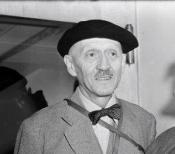
War Memorial
| Lieutenant Colonel Edgar Carnegie ANSTEY DSO, Legion of Honour (Croix de Chevalier), Croix | |
|
Royal Artillery and Staff Date of birth: 11th May 1882 Date of death: 6th November 1958 Died aged 76 Unknown |

|
| Edgar Carnegie Anstey was born at Beacon House, Camborne in Cornwall on the 11th of May 1882 the son of Harry Anstey, a civil engineer, and Edith Euphemia (nee Carnegie) Anstey of 59 Cadogan Square London. He was educated at Hazelwood School until December 1895, where he was a member of the Cricket XI and the Football XI in 1895. The school magazine wrote of his 1895 cricket season: - "A very good and steady little bat, cuts nicely off his left leg and plays good bowling as well as anyone. A fair field but not safe, and a moderate bowler. Will have left by next summer." The magazine wrote of his 1895 football season: - "An excellent little player, equally useful anywhere, usually half-back centre, a capital shot and when he played forward was quite brilliant; altogether, quite first rate." When he left, the school magazine wrote: - "...goes to Wellington, much to the advantage of that College. Above the average in work, and of irreproachable character, he only wants an increase of stature to be quite first rate in Cricket, Football and all branches of athletics. He is also a very useful chorister." He went on to Wellington College where he was in Mr. Brougham’s House from January 1896 to 1899. In November 1899 he passed 20th out of 130 candidates in the entrance examinations for the Royal Military College Academy Woolwich. He was commissioned as a 2nd Lieutenant in the Royal Artillery on the 21st of December 1900. He was promoted to Lieutenant on the 21st of December 1903. He was seconded for service in West Africa on the 13th of April 1907 where he was attached to the 1st Gold Coast Regiment as Intelligence Officer and served as Aide De Camp to the Governor of Accra until 1909. He returned to his regiment on the 2nd of February 1910 and was posted to the 135th Battery, 32nd Brigade, Royal Artillery. He won the Royal Artillery Steeplechase at the Aldershot Command in 1910 riding his own horse and followed this by winning the First Cavalry Brigade Open Light Weight Race the same year. He was seconded for a course at the Staff College at Camberley on the 22nd of January 1912. While he was there he was promoted to Captain on the 10th of May 1913 and he graduated at the end of that year. He rode his own horse to victory in the Gold Cup at the Royal Artillery Steeplechase at Aldershot on the 29th of March 1913. Following the outbreak of war he embarked for France on the 12th of August 1914 and was appointed as Brigade Major of the 1st Divisional Artillery on the 16th of November 1914. He was posted to the Dardanelles where he was mentioned in despatches for “gallant and distinguished services” during the period of Sir Charles Munro’s command of the Mediterranean Expeditionary Force and was mentioned in Sir Ian Hamilton’s despatches of the 11th of December 1915. He was later mentioned in despatches again for service in France as a General Staff Officer Grade 1. He was promoted to Major on the 13th of August 1915 and was appointed as a General Staff Officer Grade 2 on the 24th of August 1915. He was awarded the Legion of Honour (Croix De Chevalier) on the 30th of March 1916. He was promoted to Brevet Lieutenant Colonel on the 3rd of June 1917 and finished the war on the staff of 50th (Northumbrian) Division. He was awarded the Distinguished Service Order in the New Years Honours List of the 1st of January 1919 and was awarded the Croix De Guerre on the 7th of January 1919. He was promoted to temporary Colonel on the 3rd of June 1921. From 1920 to 1922 he served as chief staff officer to the armaments sub commission of the Inter Allied Control Commission in Germany and from 1924 to 1927 he served in India as an instructor at the Senior Officer’s School at Belgaum. He was promoted to Lieutenant Colonel on the 6th of April 1929 and to Colonel on the 20th of May 1931, but with seniority from the 3rd of May 1921. He was promoted to temporary Brigadier on the 20th of May 1931 when was appointed to the Command of the Royal Artillery on the General Staff, Western Command in India. He retired from the army on the 20th of May 1935 and left the service with the honorary rank of Brigadier in the Regular Army Reserve of Officers. Before the outbreak of war in 1939 he was appointed as Passive Air Defence Officer for the London district and after special employment at Southern Command in 1940 he became a member of the historical section of the Cabinet Office. He retired from the Reserve of Officers on the 25th of May 1942, having reached the maximum age limit, and became Military Correspondent of the Sunday Times and the Daily Sketch and after two years, joined the Daily Despatch and the Sunday Chronicle. He was a member of the Junior Naval and Military Clubs. He was married to Laura (nee Samsonov) at All Saints Church, Ennismore Gardens on the 21st of December 1922; they had a daughter, Barbara, born on the 20th of June 1924 and lived at 11 Thurloe Square, London SW7. When his wife died in 1946 he was married again in 1951 to Millicent Campbell daughter of the Comptesse de Prologue . He wrote the novels "A Vanishing Yacht. A Story of Adventure", published in 1936, "The Mystery of the Blue Inns", published by Longmans and Green in 1937, and contributed to the book “Shots in the Dark, published in 1951 by Allan Wingate, which was a collection of reviewer's opinions of some of the leading films released between January 1949 and February 1951 for the British branch of the International Federation of Film Critics. It was published in 1951 by Allan Wingate. He also wrote the book “Committees, How They Work and How to Work Them” which was published in 1945 and was illustrated by Norman Thelwell. He also wrote “Staff Appraisal and Development”, "Love Poems of a Young Man", published by the Fortune Press in 1943, and "Peace in Our Time", published in 1945. |
|
| Went on to Wellington College |
Back